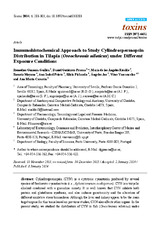Mostrar el registro sencillo del ítem
Immunohistochemical Approach to Study Cylindrospermopsin Distribution in Tilapia (Oreochromis niloticus) under Different Exposure Conditions
| dc.contributor.author | Guzmán-Guillén, Remedios | |
| dc.contributor.author | Gutiérrez-Praena, Daniel | |
| dc.contributor.author | Risalde, M.A. | |
| dc.contributor.author | Moyano Salvago, M. Rosario | |
| dc.contributor.author | Prieto, Ana Isabel | |
| dc.contributor.author | Pichardo Sánchez, Silvia | |
| dc.contributor.author | Jos Gallego, Ángeles Mencía | |
| dc.contributor.author | Vasconcelos, Vitor | |
| dc.contributor.author | Cameán Fernández, Ana María | |
| dc.date.accessioned | 2017-11-07T10:15:19Z | |
| dc.date.available | 2017-11-07T10:15:19Z | |
| dc.date.issued | 2014 | |
| dc.identifier.uri | http://hdl.handle.net/10396/15332 | |
| dc.description.abstract | Cylindrospermopsin (CYN) is a cytotoxic cyanotoxin produced by several species of freshwater cyanobacteria (i.e., Aphanizomenon ovalisporum). CYN is a tricyclic alkaloid combined with a guanidine moiety. It is well known that CYN inhibits both protein and glutathione synthesis, and also induces genotoxicity and the alteration of different oxidative stress biomarkers. Although the liver and kidney appear to be the main target organs for this toxin based on previous studies, CYN also affects other organs. In the present study, we studied the distribution of CYN in fish (Oreochromis niloticus) under two different exposure scenarios using immunohistochemical (IHC) techniques. In the first method, fish were exposed acutely by intraperitoneal injection or by gavage to 200 µg pure CYN/Kg body weight (bw), and euthanized after 24 h or five days of exposure. In the second method, fish were exposed by immersion to lyophilized A. ovalisporum CYN-producing cells using two concentration levels (10 or 100 µg/L) for two different exposure times (7 or 14 days). The IHC was carried out in liver, kidney, intestine, and gills of fish. Results demonstrated a similar pattern of CYN distribution in both experimental methods. The organ that presented the most immunopositive results was the liver, followed by the kidney, intestine, and gills. Moreover, the immunolabeling signal intensified with increasing time in both assays, confirming the delayed toxicity of CYN, and also with the increment of the dose, as it is shown in the sub-chronic assay. Thus, IHC is shown to be a valuable technique to study CYN distribution in these organisms. | es_ES |
| dc.format.mimetype | application/pdf | es_ES |
| dc.language.iso | eng | es_ES |
| dc.publisher | MDPI | es_ES |
| dc.rights | https://creativecommons.org/licenses/by/4.0/ | es_ES |
| dc.source | Toxins, 6(1), 283-303 (2014) | es_ES |
| dc.subject | Cylindrospermopsin | es_ES |
| dc.subject | Aphanizomenon ovalisporum | es_ES |
| dc.subject | Oreochromis niloticus | es_ES |
| dc.subject | Immunohistochemistry | es_ES |
| dc.subject | Distribution | es_ES |
| dc.subject | Cyanobacteria | es_ES |
| dc.subject | Cyanotoxin | es_ES |
| dc.title | Immunohistochemical Approach to Study Cylindrospermopsin Distribution in Tilapia (Oreochromis niloticus) under Different Exposure Conditions | es_ES |
| dc.type | info:eu-repo/semantics/article | es_ES |
| dc.relation.publisherversion | http://dx.doi.org/10.3390/toxins6010283 | es_ES |
| dc.relation.projectID | Junta de Andalucía. P09-AGR-4672 | es_ES |
| dc.relation.projectID | Gobierno de España. AGL2009-10026 | es_ES |
| dc.relation.projectID | Unión Europea. COST Action ES 1105 | es_ES |
| dc.rights.accessRights | info:eu-repo/semantics/openAccess | es_ES |

